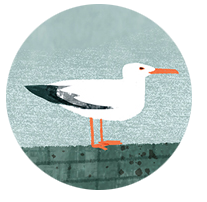
The open-hearth fireplace, with the crook and the black hanging pot, occupies most of the wall right. A string is stretched across the breast of the fireplace as a clothes-line. In the corner close to the fireplace, is a settle bed which is concealed behind curtains. Next to the bed is a kitchen table positioned in front of a small square window. The window is curtained with lace. Beside the table is a dresser, fully stocked with plates, cups, bowls, etc. Next to the dresser is the double door. When the big door is open we can see the half-door beyond it. Left of the door is a large churn; a creel for holding turf; a wooden flail. On the wall left there are three wooden posts complete with chains where cows were chained during milking. (A hundred years ago this was the area of the house where animals were bedded at night.)
Early in October. The action takes place in a ‘traditional’ Irish cottage. Every detail of the kitchen and its furnishings is accurate of its time (from 1900 to 1930). But one quickly senses something false about the place. It is too ‘pat’, too ‘authentic’. It is in fact a restored house.
BARNEY: Welcome home to handsome Ballybeg.
![]()
JACK: Everybody’s grandmother was reared in a house like this. The ancestral seat of the McNeilis dynasty, restored and refurbished with love and dedication, absolutely authentic in every detail…This is where we all come from. This is our first cathedral. This shaped all our souls.
![]()
NORA: Ah sure what news would there be in a place like this? Sure we see nobody and hear nothing here. I’m sure you were never in as backward a place as this, Tim?
![]()
DONOVAN: Really magnificent. This is what I need – this silence, this peace, the restorative power of that landscape.
![]()
TIM: Exactly. Words. Language. An agreed code. I encode my message; I transmit it to you; you receive the message and decode it…All social behaviour, the entire social order, depends on our communicational structures, on words mutually agreed on and mutually understood. Without that agreement, without that shared code, you have chaos.
BRIAN FRIEL: I want it to be seen in tandem with Translations. ¹
BRIAN FRIEL: In the case of Translations we were talking about the function of a fractured language, an acquired language and a lost language. In this case it’s saying… that perhaps communication isn’t possible at all. Right. One of the lines in the play is ‘Maybe silence is the perfect discourse.’²
Communication Cord Stage Set. On the wall left there are three wooden posts complete with chains where cows were chained during milking. (A hundred years ago this was the area of the house where animals were bedded at night.)
Translations Stage Set. Along the back wall are the remains of five or six stalls – wooden posts and chains – where cows were once milked and bedded.
BRIAN FRIEL: That this whole business of failures of communication and even in the term the communication cord, I think, suggests some kind of alarm and disaster.³
BRIAN FRIEL: Well a farce is a very serious enterprise… But then, I think that it’s a perfectly valid way of looking at people in Ireland today, that our situation has become so absurd and so… crass that it seems to me it might be a valid way to talk and write about it.4
✭ Erving Goffman’s Forms of Talk (1981),
✭ John McGrath’s A Good Night Out (1981)
✭ George A. Miller’s Language and Speech (1981)
✭ Michael Frayn’s new play ‘Noises Off’ at the Lyric Theatre. Hammersmith, printed in The Times Literary Supplement
✭ ‘Essay: A National Dream-Life’ by David Mamet
The Real Centre
A Little Gallagher
People In Thatched Cottages
A Common Code
✭ The Communication Cord, Book Jacket, courtesy of The Gallery Press
✭ Postcard of Loughross Beg – Ardara, Courtesy of Donegal County Museum
✭ The Communication Cord, Programme, The Field Day Theatre Company 1982
✭ Photos of the Mellon Homestead at The Ulster American Folk Park, Omagh, taken by Harriet Purkis
✭ Poster and images of Performance courtesy of Corn Mill Theatre
✭ The Communication Cord (1982) by Brian Friel (London: Faber & Faber) 1983
✭ ¹In Interview with Fintan O’Toole (1982) in Murray, Christopher (ed.) Brian Friel: Essays, Diaries, Interviews : 1964-1999. London: Faber& Faber, 1999, p.113
✭ ²&4In Interview with Ray Comiskey (1982) in Murray, Christopher (ed.) Brian Friel: Essays, Diaries, Interviews : 1964-1999. London: Faber& Faber, 1999, p.102-103
✭ ³Brian Friel and Field Day Radio Telefís Éireann (1983) in Delaney, Paul (ed.) Brian Friel in Conversation. Ann Arbor: The University of Michigan Press 2000, p.180
✭ Courtesy of the National Library of Ireland
✭ National Library of Ireland Collection List No. 73 BRIAN FRIEL PAPERS, MS 37,093 /1
✭ National Library of Ireland Collection List No. 73 BRIAN FRIEL PAPERS, MS 37,093 /2 – 3

An Action of the County Donegal Heritage Plan
© 2024 | Donegal County Council. All rights reserved.